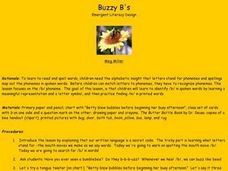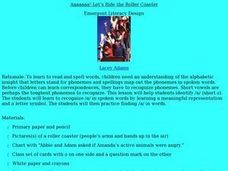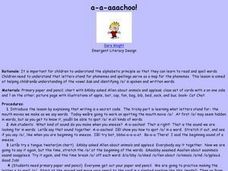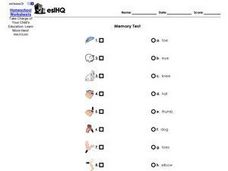Curated OER
Meet Your Tonsils
Students engage in a lesson that is concerned with tonsils. They identify the parts of the face and mouth as shown on a poster and then conduct class discussion about the function and location of the tonsils. The lesson includes related...
Curated OER
Icky Sticky Goo
Students identify the letter I and the /i/ sound that it makes. They practice reading the tongue twister together, shaking their hands when they hear the /i/ sound and draw out the /i/ sound in each word. Finally, students write a...
Curated OER
Music: Rhythm Patterns
Fourth graders describe and play various tempos as part of this beginning instrumental instructional activity. They recite tongue twisters to a medium, largo, and allegro tempos. As an extension, 4th graders use software as an...
Curated OER
Sally Snake
Students study the /s/ phoneme by examining the sound in written and spoken words. They recite a tongue twister, and examine how their mouths move as they make the sound. Next, they write the letter, differentiate the sound in given...
Curated OER
The Iddy Biddy Igloo
Students identify and recognize the short vowel /i/ in spoken and written words. They identify the short /i/ sound and its letter symbol. They say a tongue twister emphasizing the short /i/ sound, and identify the words with /i/ in the...
Curated OER
Ehhh! Can you repeat that!
Students assess how to recognize phonemes that stand for letters creating spoken words utilizing the short vowel /e/. They associate our written language as a secret code to solve. The tongue twister "Everybody saw Eddie and the Eskimo...
Curated OER
Ohhhh Wheeee!!!!
Students complete a variety of activities as they explore the long /E/ sound. They recite tongue twisters, practice writing words with the long /E/ sound (especially those using 'ee'), and read and identify long /E/ words in the story,...
Curated OER
Eeeee -- It's a Mouse!
Students recognize the long "e" sound, and identify it in spoken words by learning letter symbols. Students participate in role playing and tongue twisters to learn the long "e" sound. By learning phenomes, students are taking the...
Curated OER
Ah Ah Ah! Don't Do That!
Students become familiar with the alphabetic principle that letters stand for phonemes and spellings map out the phonemes in spoken words. They focus on identifying the short /o/ sound in spoken words and the tongue twister "Oscar Otter...
Curated OER
Match It!
In this ESL transportation vocabulary worksheet, students analyze 7 pictures that depict different body parts. Students match these pictures with the words that describe them.
Curated OER
Slithering Silly Snakes
First graders identify the letter and phoneme /s/ in written and spoken language. Students practice the production of the /s/ sound through tongue twisters. They identify the initial placement of the letter and sound by creating a...
Curated OER
I Think I Can
Students identify the digraph /ch/ in written and spoken language. Students practice the production of the /ch/ sound through tongue twister. They identify the initial and final placement of the digraph /ch/ by reading a story to a partner.
Curated OER
Buzzy B's
Students identify /b/ in spoken words and recognize the letter symbol b in written words. They say a tongue twister which contains words with /b/. They then listen the the book "The Butter Battle Book" by Dr. Suess and identify the...
Curated OER
Aaaaaaa! Let's Ride the Roller Coaster
Students complete a variety of activities related to the short /a/ sound. As a class they recite a tongue twister, then trace and write the letter A. Students then listen to word pairs and identify which word in each word pair contains...
Curated OER
A-a-aaachoo!
Students complete a variety of activities related to the short /a/ sound. As a class they recite a tongue twister, and trace and write the letter A. Students then view a stack of picture cards and identify the words containing the short...
Curated OER
Let's Read and Read!
Students discover how to hold their mouths to form the /o/ sound and that it may be hidden in different words. They say /o/ and then repeat a tongue twister that contains many /o/ words and practice writing it on primary lined paper....
Curated OER
ESL Body Words Matching Worksheet
In this ESL body words matching worksheet, students match 10 clip art pictures of body parts with their names. They match words such as hand, elbow, toes, and knee.
Curated OER
Memory Test
In this vocabulary learning exercise, students match ten pictures with their names. Seven of the terms are body parts, two are animals, and the tenth term is hat. This learning exercise is intended to be used with English language learners.
Curated OER
My Body
In this body word and picture match worksheet, students examine 7 pictures of parts of the body. Students match these to the words that describe them.
Curated OER
"Shhh!" said Miss Trish
Pupils explore the /sh/ digraph and how it is a blending of the /s/ and /h/ sounds. They listen to and then repeat /sh/ tongue twisters. They listen for and identify /sh/ words in 'One Fish, Two Fish, Red Fish, Blue Fish' by Dr. Seuss.
Curated OER
Billy's Blue Ball
Pupils explore the letter B, the /b/ sound, and identify the letter B in words. Students read a tongue twister emphasizing the /b/ sound. They then practice writing the letter /b/ while saying the sound. Finally, they complete an...
Curated OER
Bump on the Head
Students discuss as a class if they have ever had a bump on the head and started crying and said /a/. They pretend they have hit their head and say the /a/ stretching it out and try a tongue twister containing the sound and write the...
Curated OER
Lizzy the Icky Sticky Piggy
Young scholars read and spell words using the short letter "I". They become familiar with the letter "I" in spoken words by a meaningful representation and a letter symbol. Students come up with words with the sound and review the tongue...
Curated OER
Prepositions
For this preposition worksheet, students read 10 prepositions and match them to the picture that correctly illustrates the word. This is intended for ESL students but can be used by all.























